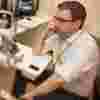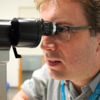Prof Pearse Keane has created a database linking millions of retinal images with healthcare data. One day, this could mean conditions like heart disease and dementia are diagnosed early with a simple eye scan, meaning people can start treatment sooner.
For more than 100 years, we’ve known the eyes can provide a window into people’s health. Changes to the blood vessels and nerves of the retina reflect diseases that affect the circulation – such as heart disease, stroke, and diabetes – and neurological conditions like Alzheimer’s, the most common cause of dementia. This raises the possibility of using eye scans to diagnose illnesses, maybe years before other symptoms appear.
But this tantalising opportunity has long seemed unachievable – until now.

Pieces of the puzzle
Prof Pearse Keane is an ophthalmologist at University College London, Institute of Ophthalmology and Moorfields Eye Hospital NHS Foundation Trust, and leads a research team at University College London. Three things have come together, Pearse believes, that have allowed his team to make progress towards diagnosing diseases using eye scans.
The first is the millions of images of the eyes of hundreds of thousands of patients at Moorfields, taken over many years. Second is the use of Artificial Intelligence (AI) to spot differences in these images that are too subtle for humans to see, at a scale that would be impossible for humans to do.
The third is ‘Hospital Episode Statistics’: huge amounts of healthcare data collected about every NHS patient who attends hospital for a diagnosis or treatment.
“This light bulb went off in my brain: we have all this retinal imaging at Moorfields, could we get permission to link that data to the national database of Hospital Episode Statistics?"
Creating the AlzEye database
Pearse’s idea was to link the retinal images to healthcare data from the same people, enabling the research needed to make diagnosing diseases with eye scans a reality. To do this, Pearse and his colleague Dr Siegfried Wagner were awarded a small grant of just £15,000, funded jointly by Fight for Sight and Alzheimer’s Research UK. “It was perfect timing,” says Pearse. “It was probably the most impactful £15,000 of funding that I could ever imagine.”
Linking the data took a long time, because their plans had to be approved by several different committees for research ethics and data privacy, as well as by patients.
But after two years of work, approval for the data linkage was finally granted at the end of 2019. The ‘AlzEye’ database contains more than 6 million retinal images from over 150,000 people, anonymously linked to data from their hospital visits, making it the largest research database of its kind in the world.
Major discoveries
As soon as the AlzEye database was created, Pearse and his colleagues put this data to use. One discovery, which made headlines around the world, was that changes to the retina in Parkinson’s disease can appear up to seven years before other symptoms. Pearse’s team are currently exploring retinal changes linked to heart disease, stroke, as well as Alzheimer’s and dementia.

“I feel like we’ve barely scratched the surface of what we’re going to achieve from this work."
Vision for the future
The AlzEye database is a unique resource for research. The goal of diagnosing diseases with eye scans is still many years away, and it’s not yet clear which conditions could be diagnosed like this. But Pearse believes that if this could be achieved for even just one disease, it will transform public health.
Earlier treatment could slow down the progression of disease – and give people more time to enjoy life with better health.
Related content


